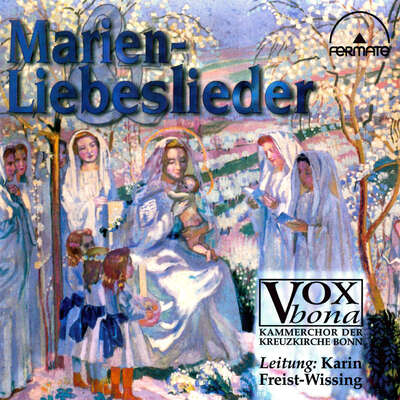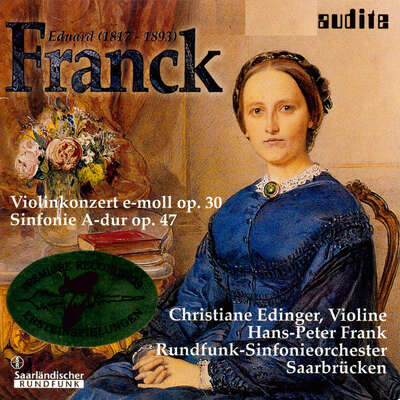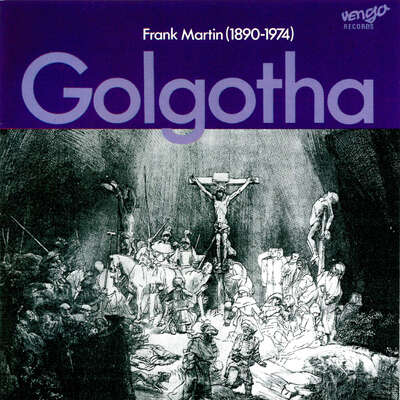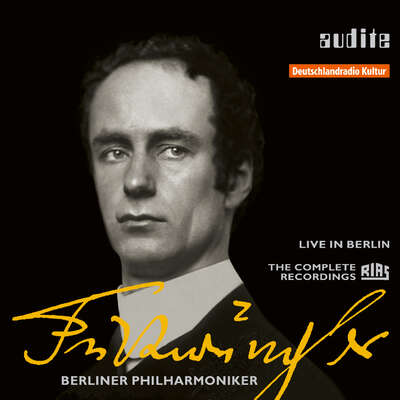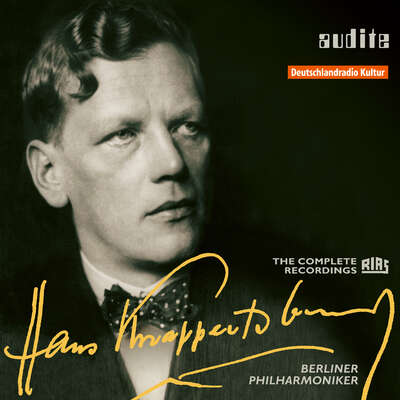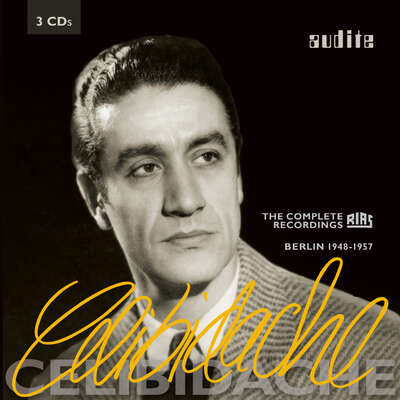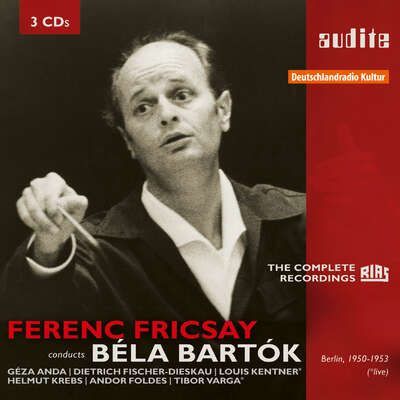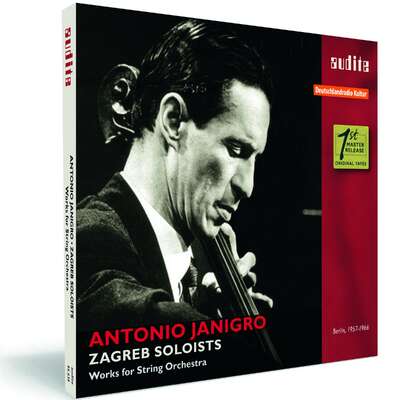
In the 1950s Ferenc Fricsay was almost the only conductor to perform Rossini’s Stabat mater in Germany. Composed for Paris, this late work by the opera composer held a difficult standing at the other side of the Rhine; its operatic expression was met with considerable aesthetic opposition in...more
"Fricsay in concert, and a dramatic reading of Rossini's sacred masterpiece." (Gramophone)
Details
| Edition Ferenc Fricsay (XI) – G. Rossini: Stabat Mater | |
| article number: | 95.587 |
|---|---|
| EAN barcode: | 4022143955876 |
| price group: | BCB |
| release date: | 13. March 2009 |
| total time: | 58 min. |
Bonus Material
Informationen
In the 1950s Ferenc Fricsay was almost the only conductor to perform Rossini’s Stabat mater in Germany. Composed for Paris, this late work by the opera composer held a difficult standing at the other side of the Rhine; its operatic expression was met with considerable aesthetic opposition in the country which had only just found its sacred music ideal in Mendelssohn’s revival of Bach’s St Matthew Passion and Mendelssohn’s own oratorios.
With this interpretation of the Stabat mater Fricsay demonstrates that Rossini’s music does not merely consist of effective solo numbers which are accompanied by a spirited orchestra. Simply by casting singers such as Maria Stader and Ernst Haefliger, who generally showed a more instrumental or lied-like approach, Fricsay reveals his discovery of subtle musical interactions in Rossini’s seemingly apparent dramaturgy. The RIAS Symphony Orchestra, made into an ensemble of international standing by Fricsay, realises his intentions in a precise and unpretentious fashion.
On audite.de you can find a “Producer’s Comment” from producer Ludger Böckenhoff about this production as well as the historical concert program from September 1954 in Berlin.
The production is part of our series „Legendary Recordings“ and bears the quality feature „1st Master Release“. This term stands for the excellent quality of archival productions at audite. For all historical publications at audite are based, without exception, on the original tapes from broadcasting archives. In general these are the original analogue tapes, which attain an astonishingly high quality, even measured by today‘s standards, with their tape speed of up to 76 cm/sec. The remastering – professionally competent and sensitively applied – also uncovers previously hidden details of the interpretations. Thus, a sound of superior quality results. CD publications based on private recordings from broadcasts cannot be compared with these.
Reviews
Die Tonkunst | Juli 2013 | Tobias Pfleger | July 1, 2013 Edition Ferenc Fricsay – Werke von Haydn, Mozart, Beethoven, Rossini, Bizet, Brahms, Strauß, Verdi, Bartók u. a.
Ferenc Fricsay gehörte zu den bedeutenden Dirigenten des mittleren 20.Mehr lesen
Classic Collection | THURSDAY, DECEMBER 9, 2010 | December 9, 2010
In the 1950s Ferenc Fricsay was almost the only conductor to performMehr lesen
Fanfare | Issue 33:3 (Jan/Feb 2010) | Jerry Dubins | January 1, 2010
This is Volume 11 in Audite’s “Edition Ferenc Fricsay,” a superb, ongoing series dedicated to remastering and restoring to the catalog many ofMehr lesen
It’s been said, facetiously, that the Requiem is Verdi’s greatest opera, the implication being that the composer couldn’t tell the difference between a “Libiamo, libiamo ne’ calici” and a “Libera me.” I choose not to believe that of Verdi, but of Rossini, I’m not so sure. For if there is a musical setting of a sacred text that surpasses the incongruity of his Petite Messe solennelle, it would have to be this Stabat mater. And while the score, taken on its own, is not entirely frivolous, it is operatic through and through, and not really in keeping with this most deeply moving hymn to the suffering of the Virgin Mary.
For this performance, Fricsay assembled an all-star, world-class quartet of vocal soloists known for their outstanding work in many of the sacred choral masterpieces by Bach, Haydn, Mozart, Cherubini, Bruckner, and Dvořák, as well as for their appearances on the operatic stage. One would expect this broad range of experience and diversity of singing styles to find a happy medium in a reading of Rossini’s Stabat mater, and to convey a modicum of balance between the stile antico, which the seriousness of the text calls for, and the music—“A drinking song under the cross,” the title of the booklet essay calls it (a reference to the Cujus animan gementem)—which is largely at odds with it. And on balance, this is what we get, though without text in hand, one could be excused for mistaking a passage or two for an excerpt from William Tell. Fault lies not with the soloists, choirs, orchestra, or Fricsay who, as was his wont, moves things along at a quickened pace; the liability is entirely Rossini’s.
Peter Uehling’s essay, the crucial points of which seem to jibe with other accounts I’ve read, tells us that the composer began work on the Stabat mater in 1831, but then lost interest after having written six of its 10 movements—1 and 5 through 9. A Spanish cleric and friend, Giuseppe Tadolini, completed the score, which eventually wound up in the hands of a French publisher. Rossini was not pleased to discover this unauthorized publication and decided to offer his own newly completed version to another publisher. By this time Tadolini was dead, but his publisher sued. Eventually, Rossini won the case, and it’s in the composer’s final 1842 version that the work is heard today.
As archival material that documents the accomplishment of one of the great conductors of the 20th century, not to mention the artistry of some of its finest singers, this release will be indispensable to Fricsay collectors. The sound on this disc, however, does not match the excellence of that achieved on Volume 10 of this series, a 1951 studio recording Fricsay made of the Brahms Violin Concerto with Gioconda de Vito, reviewed in 33:2. The current recording sounds a bit constricted, recessed, and muffled in the loudest passages.
It’s hard for me to imagine anyone being truly desperate for a recording of Rossini’s Stabat mater, but if it’s the piece itself you’re interested in, there are quite a few later ones available in far better sound and in performances at least equal to if not superior to this one—Kertész with Lorengar, Minton, Pavarotti, Sotin, and the LSO comes to mind—but again, this is for Fricsay fans and for those collecting the Audite series.
Gramophone | October 2009 | Richard Osborne | October 1, 2009 Fricsay in concert, and a dramatic reading of Rossini's sacred masterpiece
This is not a reissue of Fricsay’s memorable 1954 DG recording of Rossini’s Stabat Mater but a live performance given with identical forces inMehr lesen
Anyone familiar with Fricsay’s celebrated 1953 DG Verdi Requiem will know how fiery and expressive his direction is. And how scrupulous. No Italian conductor on record has dared to take Rossini's tempo markings in the work's opening and closing movements as literally as Fricsay. The Introduzione in particular benefits enormously from his swift and involving reading. Text matters as much to Fricsay (a devout Roman Catholic) as it did to Rossini, whose reading of the Latin poem was more comprehending than the "What's he doing writing religious music?" brigade could begin to imagine.
Even the assiduous Fricsay has trouble keeping tabs on Kim Borg in the "Pro peccatis" (which lacks its opening drumroll) but elsewhere his deeply felt moulding of the text draws memorable responses from his singers, not least Maria Stader in a thrilling and mercifully unoperatic "Inflammatus". Ernst Haefliger's account of the "Cuius animam" is one of the finest on record, die final top D flat perfectly sounded.
Though this ensemble of Berlin choirs was probably as fine as any in Europe at the time, the perils of live performance take their toll in the unaccompanied "Eja mater" which ends up a semitone sharp (the choir is better in tune in "Quando corpus morietur"). This, however, is a small price to pay in an otherwise accomplished live performance that has about it the true blaze of faith.
Pizzicato | N° 195, 9/2009 | Alain Steffen | September 1, 2009 Aus den Archiven
Vier weitere Veröffentlichungen aus dem historischen Archiv, wobei aber nur zwei wirkliches Interesse verdienen. Kaum erwähnenswert bleibt KarlMehr lesen
Auch Fricsays Einspielung von Rossinis Stabat Mater gehört nicht zu den Meilensteinen dieses genialen Dirigenten. Und das liegt nicht einmal am Dirigenten selbst, der allen Klischees zum Trotz einen spannenden und reliefreichen Rossini dirigiert und sich demnach nicht mit reinem Schönklang zufrieden gibt. Allerdings passen die vier Solisten, insbesondere Maria Stader und Ernst Haefliger stimmlich ganz und gar nicht zu Rossinis geistlichem Werk. Da ist einfach zu viel Mozart und zu wenig Rossini. Zudem gehen beide Sänger bis an Grenzen, die uns dann einige unschöne Momente bescheren. Etwas besser sind Marianna Radev und Kim Borg in den tiefen Registern. Doch der Mangel an Homogenität im Solistenquartett wirkt sich durchgehend negativ auf die Gesamtkonzeption aus.
Herausragend dagegen ist die Einspielung der Klavierkonzerte Nr. 19 & 20 von W.A. Mozart. Man kennt Haskils Stil, aber in jeder ihrer Aufnahmen betört diese Pianistin den Zuhörer mit ihrer ungeheuren Sensibilität und ihrem Sinn für Schönheit und Stil. Fricsay, selbst einer der großen Mozart-Interpreten der Fünfzigerjahre, ist ein idealer Partner für Clara Haskil und so präsentieren beide einen hochrangigen Mozart, der nichts von dem zuckersüßen Wolfgang wissen wollte und demnach durch seine Modernität seiner Zeit weit voraus war. Und dennoch: Die schönste Aufnahme dieses Doppelalbums ist Beethovens 4. Klavierkonzert das unter Haskils Fingern eine schier göttliche Dimension erreicht. Obwohl der heute vergessene Dean Dixon sich Beethoven eher mit einer sehr dynamischen und sportlichen Leseart nähert und so einem Konzept nachgeht, das sich grundlegend von dem einer Clara Haskil unterscheidet, so bildet gerade diese unterschiedliche Basis ein solides Terrain für eine der sicherlich spannendsten Beethoven-Auseinandersetzung der Discographie. Dean Dixon war übrigens der erste afroamerikanische Dirigent, der an der Spitze von renommierten Symphonieorchestern stand. Wegen seiner Hautfarbe hatte er es allerdings in Amerika recht schwer und so konzentrierte er sich hauptsächlich auf Australien und Europa. 1970 kehrte er allerdings nach Amerika zurück und wurde triumphal gefeiert. Der 1915 in New York geborene Dirigent starb 1976 in der Schweiz.
American Record Guide | September/October 2009 | Greenfield | September 1, 2009 Rossini: Stabat Mater
A remarkable offering on several counts. First, there's the sound, which is unbelievably good for a 1954 concert performance. Yes, the brasses can beMehr lesen
What will affect you the most, I suspect, is Fricsay's conception of the piece and the artistry he brought to it. A devout Catholic, he loved this Stabat Mater, programming it numerous times in an era when no other conductor active in Germany would go near it. He approached Rossini's handiwork with reverence, refusing to simply ladle on the marinara and let the operatic games begin. His soloists do not have big, juicy voices, though the bass is plenty dark and deep when the occasion calls for it. Indeed, there's an intimacy to the singing that seems more suited to an oratorio than to opera. The voices are beautiful as well – bel canto. So while Haefliger may not leap tall phrases at a single bound, his 'Cujus animam' is warm, humane, and more prayerful than most. (With a pretty convincing high D-flat tacked on for good measure, I might add.) Maria Stader's 'Inflammatus' is less a fiery anticipation of Judgement Day than an inner cry for the soul to be cleansed. And never has the 'Qui est homo' duet sounded more compassionate, with the alto and soprano knowingly contemplating the mother's anguish as her son undergoes the agony of the cross.
In some of the most powerful conducting I've heard in a long time, Fricsay builds it all up interlude by interlude, aspiration by aspiration, and prayer by prayer into a true journey of faith. It's a revelatory performance that hangs together tautly, yet every word of text is savored and no rose is left unsmelled. Our perceptions of Rossini, I suspect, have been colored by the familiar idea that his Stabat Mater is a superficial affair where hot tunes trump any and all yearnings of the spirit. Think again. Under the baton of a great conductor, yet another bit of "conventional wisdom" bites the dust.
Ópera Actual | Julio 2009 | Albert Torrens | July 1, 2009
El binomio Gioachino Rossini y música sacra siempre plantea a losMehr lesen
Scherzo | Julio 2009 | Enrique Pérez Adrián | July 1, 2009
Audite Edición Fricsay
Una Joya
Prosigue el sello alemán Audite (distribuidor: Diverdi) con su magníficaMehr lesen
Financial Times | July 2009 | July 1, 2009
The Hungarian conductor Ferenc Fricsay, who died in 1963 aged 48, was oneMehr lesen
Audiophile Audition | June 07, 2009 | Gary Lemco | June 7, 2009
Audite restores the live recording of 22 September 1954 from the UniversityMehr lesen
www.classicstodayfrance.com | Mai 2009 | Christophe Huss | May 1, 2009
Ferenc Fricsay est toujours à l'aise pour "faire parler" les oeuvresMehr lesen
Journal de la Confédération musicale de France | Mai/Juin 2009 | Jean Malraye | May 1, 2009
Les CD de Jean Malraye
Musique Sacrée
Dès l'introduction, FRICSAY installe son interprétation dans uneMehr lesen
Westdeutsche Allgemeine Zeitung | 30. März 2009 | Lars von der Gönna | March 30, 2009 Passion ohne hohles Pathos
Auch ein Mythos, dass alle uralten Klassik-Aufnahmen die besseren sind. DerMehr lesen





















